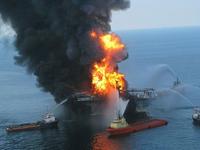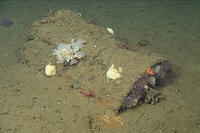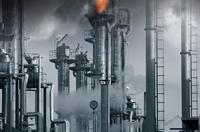-
Deepwater Horizon: Identifying harmful elements of persisting oil

Scientists are unraveling the composition of persisting oil residues collected from Gulf of Mexico beaches following the Deepwater Horizon disaster, insisting on further assessment of the toxic impact of these chemical remnants on the marine ecosystem. A new study targeted the most abundant compounds in the residual oil, dissecting their composition with unprecedented accuracy. This is important for understanding the environmental impact of persisting oil remnants, because ecotoxicologists have demonstrated that all three chemical groups can be harmful to living organisms. More worrisome, relatively little is known about the broader toxicity of saturates and oxygenated hydrocarbons in the marine ecosystem, like the Gulf of Mexico —where there are 223 offshore oil rigs — even though these compounds constitute most of the persisting oil.
-
-
Using pencil and paper to detect hazardous chemicals
Three students from Northwestern University have proven that pencils and regular office paper can be used to create functional devices that can measure strain and detect hazardous chemical vapors. The project originated during a discussion about the conductive properties of graphene, a one-atom thick layer of carbon that can be parsed from regular pencil lead.
-
-
Turkeys inspire smartphone-capable early warning system for toxins
Some may think of turkeys as good for just lunch meat and holiday meals, but University of California, Berkeley bioengineers saw inspiration in the big birds for a new type of biosensor which changes color when exposed to chemical vapors. This feature makes the sensors valuable detectors of toxins or airborne pathogens. The technology can be adapted so that smartphones can help analyze the color fingerprint of the target chemical. In the future, it could potentially be used to create a breath test to detect cancer and other diseases.”
-
-
Carbon nanotube sponge helps in water clean-up
A carbon nanotube sponge capable of soaking up water contaminants, such as fertilizers, pesticides, and pharmaceuticals, more than three times more efficiently than previous efforts has been presented in a new study published today. The carbon nanotube (CNT) sponges, uniquely doped with sulphur, also demonstrated a high capacity to absorb oil, potentially opening up the possibility of using the material in industrial accidents and oil spill clean-ups.
-
-
Toxins-breathing bacteria to help industry, environment
Preliminary tests suggest that the bacteria could be used to remove these pollutants from the wastewater and protect the surrounding ecosystems. Buried deep in the mud along the banks of a remote salt lake near Yosemite National Park are colonies of bacteria with an unusual property: they breathe a toxic metal to survive. Researchers believe that this unusual organism may one day become a useful tool for industry and environmental protection – for example, the bacteria could be used simply to clean up the water, but it might also be possible for the bacteria to help humans recover and recycle the valuable elements in the water.
-
-
Aging natural gas pipelines leak under Washington, D.C. streets
More than 5,893 leaks from aging natural gas pipelines have been found under the streets of Washington, D.C., a team of researchers finds. A dozen of the leaks could have posed explosion risks, the researchers said. Some manholes had methane concentrations as high as 500,000 parts per million of natural gas — about ten times greater than the threshold at which explosions can occur.
-
-
Small, portable, fast TLC unit for explosives, drugs analysis
Field Forensics of St. Petersburg, Florida, unveiled its microTLC, a portable and easy to use solution for pre-screening and presumptive identification of drugs and explosive mixtures. Thin layer chromatography (TLC) is an established laboratory procedure which identifies compounds belonging to the same general chemical class. The microTLC makes it possible for both laboratory and field analysis to be performed by first responders and forensics scientists.
-
-
Survey of deep-sea chemical munitions dump off California finds no chemical weapons

Since the Second World War, U.S. nautical charts have shown seven “chemical munitions dumping areas” along the Pacific Coast between San Francisco and the Mexican border. Little or no information, however, is available about the amount, location, or nature of the materials that were dumped at most of these sites. Researchers from the Monterey Bay Aquarium Research Institute (MBARI) conducted a detailed survey of one supposed deep‐water dump site off Southern California, and found that it contained no chemical munitions. The researchers conclude that not all sites marked as chemical munitions dumps may actually have been used for this purpose.
-
-
Off-shore barges considered for destroying Syria’s chemical weapons
After failing to find a country willing to allow its territory to be used for disposing of Syria’s chemical weapons, the United States is exploring other options. Two options being seriously considered involve the destruction of Syria’s chemical weapons off shore, rather than on land. Both proposals call for removing the chemical weapons from Syria and placing them on a large barge at sea, where they would be dissolved or incinerated.
-
-
Destroying Syria's chemical weapons in the midst of war
Close to 1,400 tons of chemical weapons are stored at twenty-three locations scattered throughout Syria. To destroy this stockpile, officials will need multiple strategies. The most dangerous are the munitions filled with “live” chemical agents, such as mustard gas, sarin, and VX. Dealing with these weapons will require bringing specialized equipment into the war-torn country.
-
-
Sunlight-activated nanogrid breaks down pollutants in water
Oil spills do untold damage to the environment — to the waters they pollute and to marine and other wildlife. The Deepwater Horizon spill in the Gulf of Mexico in 2010, for example, the largest accidental marine oil spill in the history of the petroleum industry, flowed unabated for three months. Typically, such oil spills are extraordinarily difficult to clean up. Soon, however, the process may become infinitely easier and ecologically friendly, the result of a new invention — “nanogrid” — a large net consisting of metal grids made of a copper tungsten oxide, that, when activated by sunlight, can break down oil from a spill, leaving only biodegradable compounds behind.
-
-
Preventing a Bhopal-like catastrophe in New Jersey
New Jersey is home to ninety facilities which produce and store large quantities of highly toxic chemicals. A superstorm or terrorist attack could doom millions of people around southern New Jersey and eastern Pennsylvania to a Bhopal, 1984-like fate if either of these facilities and their storage tanks were affected.Typically, in the aftermath of major disasters, a blue ribbon panel is created to review preventative measures that could have been taken before the disaster. Security experts say that there is no need to wait for a post-disaster blue ribbon panel investigation to know what sensible safety measures should be implemented now.
-
-
Budget impasse halts enforcement of chemical plants safety standards

Security experts say that short of a direct nuclear attack on a U.S. city, the most dangerous, mass-casualty catastrophe the United States faces is a terrorist attack on, or an accident in, a chemical facility which would release toxic clouds over neighboring cities and towns. The federal government partial shutdown is making it impossible to enforce safety and security standards formulated to strengthen the ability of thousands of U.S. chemical facilities to withstand terrorist attacks.
-
-
Furloughs hamper U.S. ability to respond to chemical disasters
Rafael Moure-Eraso, the chairman of the U.S. Chemical Safety Board(CSB) warned that the agency would be unable to respond to major chemical-related disasters if the government shutdown continued. The agency has furloughed more than 90 percent of its workers. The shutdown has delayed other CSB investigations into chemical accidents in California, Utah, Washington, and Texas. Moure-Eraso said that the delays in investigations could threaten public safety as the agency is unable to make recommendations for prevention of similar accidents.
-
-
Syria’s chemical weapons can be destroyed within nine months: experts
Weapons experts from the United States and Russia say most of Syria’s chemical weapons stockpile are kept as unweaponized liquid precursors, and thus could be neutralized in a short period of time without the risk that toxins could be stashed away by the regime for future use, or stolen by terrorists. A confidential assessment by the United States and Russia concludes that Syria’s entire arsenal could be destroyed in about nine months, assuming that Syrian officials fully cooperate with the weapons inspectors.
-
- All
- Regional
- Water
- Biometrics
- Borders/Immig
- Business
- Cybersecurity
- Detection
- Disasters
- Government
- Infrastructure
- International
- Public health
- Public Safety
- Communication interoperabillity
- Emergency services
- Emergency medical services
- Fire
- First response
- IEDs
- Law Enforcement
- Law Enforcement Technology
- Military technology
- Nonlethal weapons
- Nuclear weapons
- Personal protection equipment
- Police
- Notification /alert systems
- Situational awareness
- Weapons systems
- Sci-Tech
- Sector Reports
- Surveillance
- Transportation
Advertising & Marketing: advertise@newswirepubs.com
Editorial: editor@newswirepubs.com
General: info@newswirepubs.com
2010-2011 © News Wire Publications, LLC News Wire Publications, LLC
220 Old Country Road | Suite 200 | Mineola | New York | 11501
Permissions and Policies
Editorial: editor@newswirepubs.com
General: info@newswirepubs.com
2010-2011 © News Wire Publications, LLC News Wire Publications, LLC
220 Old Country Road | Suite 200 | Mineola | New York | 11501
Permissions and Policies
